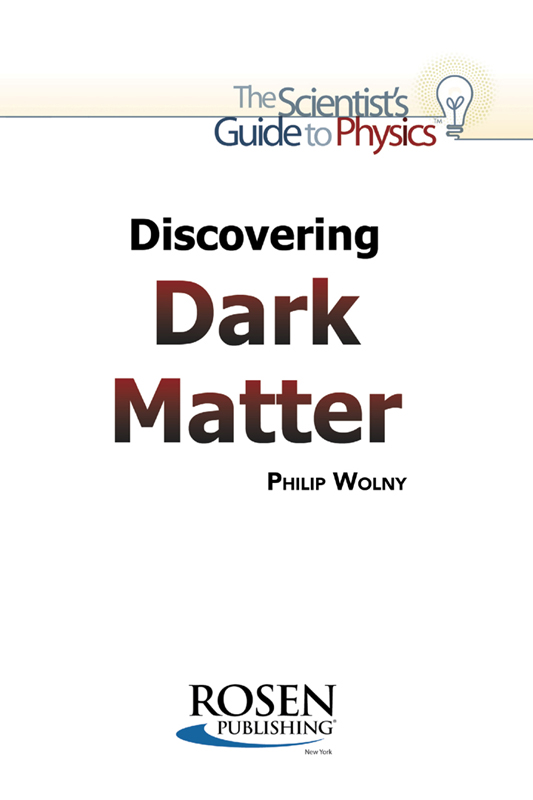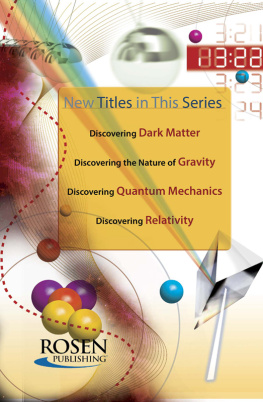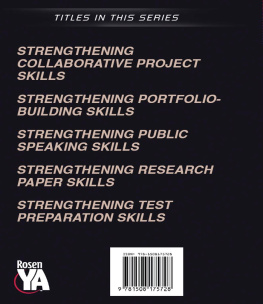Philip Wolny - Discovering Dark Matter
Here you can read online Philip Wolny - Discovering Dark Matter full text of the book (entire story) in english for free. Download pdf and epub, get meaning, cover and reviews about this ebook. publisher: The Rosen Publishing Group, Inc, genre: Art. Description of the work, (preface) as well as reviews are available. Best literature library LitArk.com created for fans of good reading and offers a wide selection of genres:
Romance novel
Science fiction
Adventure
Detective
Science
History
Home and family
Prose
Art
Politics
Computer
Non-fiction
Religion
Business
Children
Humor
Choose a favorite category and find really read worthwhile books. Enjoy immersion in the world of imagination, feel the emotions of the characters or learn something new for yourself, make an fascinating discovery.
- Book:Discovering Dark Matter
- Author:
- Publisher:The Rosen Publishing Group, Inc
- Genre:
- Rating:5 / 5
- Favourites:Add to favourites
- Your mark:
- 100
- 1
- 2
- 3
- 4
- 5
Discovering Dark Matter: summary, description and annotation
We offer to read an annotation, description, summary or preface (depends on what the author of the book "Discovering Dark Matter" wrote himself). If you haven't found the necessary information about the book — write in the comments, we will try to find it.
Discovering Dark Matter — read online for free the complete book (whole text) full work
Below is the text of the book, divided by pages. System saving the place of the last page read, allows you to conveniently read the book "Discovering Dark Matter" online for free, without having to search again every time where you left off. Put a bookmark, and you can go to the page where you finished reading at any time.
Font size:
Interval:
Bookmark:


Published in 2015 by The Rosen Publishing Group, Inc.
29 East 21st Street, New York, NY 10010
Copyright 2015 by The Rosen Publishing Group, Inc.
First Edition
All rights reserved. No part of this book may be reproduced in any form without permission in writing from the publisher, except by a reviewer.
Library of Congress Cataloging-in-Publication Data
Wolny, Philip, author.
Discovering dark matter/Philip Wolny.First edition.
pages cm.(The scientists guide to physics)
Includes bibliographical references and index.
ISBN 978-1-4777-8004-6 (library bound)
1. Dark matter (Astronomy)Juvenile literature. I. Title.
QB791.3.W65 2015
523.1126dc23
2014015412

V era Rubin was busy at work, watching the skies. It was the late 1960s, and the rest of her peers at the Department of Terrestrial Magnetism in Washington, D.C., seemed to be chasing quasars, which are bright, faraway, and mysterious objects similar to stars. Not wanting to follow the crowd, Rubin had taken another path. The astronomer, working with her colleague W. Kent Ford, was observing the movements of stars in the Andromeda galaxy, tracking how they rotated within Andromeda itself.
They looked at these stars in a way that no one else had been able to before. Ford had developed an improved version of a tool called a spectrograph, or spectrometer. It helped them see patterns invisible to the naked human eye. With it, they could also record light patterns much more quickly than earlier scientists. Rubin knew they would be able to examine star rotations that were farther from the central bulge of the galaxy than any other researchers before them.

Vera Rubin is perhaps the most important and influential astronomer in the modern era to advance and popularize the theories surrounding dark matter.
There was one problem that had not stopped nagging at Rubin since the beginning of their experiments, however. She had expected to see the outer stars of the Andromeda rotating more slowly than those closer to its center. Mapped on a graph, this rotation curve should have been similar to other orbiting bodies. In our solar system, for example, planets with bigger orbitslike Uranus and Neptunetravel slower. Earth moves around the sun more quickly than these outer planets. But as they mapped rotation in the Andromeda galaxy, Rubin and Ford found a flat line. There was no curve. This meant that all the stars moved at the same rate.
Rubin and Fords discovery called into question what scientists understood as the nature of the universe itself. Decades earlier, scientists working with more basic instruments, such as Fritz Zwicky in the 1930s, had noticed similar phenomena. The laws of physics first conceived of by Isaac Newton and later applied to the movements of galaxies and stars, sometimes called Newtonian physics, held that the masses and distances of rotating objects would determine their motions in predictable ways. The gravity of a spiral galaxy would be concentrated at its center. Therefore, stars nearer to the center would move faster than those further away due to gravitational pull. But the difference between the visible matter they witnessed and the unexpected behavior of the stars they observed meant they were on to something entirely new. There had to be some other kind of matter exerting gravitational forces on the stars that were further away from the center of a spiral galaxy.
These new and unusual findings from Rubin and Ford would lead to a worldwide search. Decades were spent on the search for a mysterious substance that may comprise most of the universe but which we know very little about: dark matter.
With improvements in the tools available for research, scientists have been able to approach the study of this mysterious substance from many angles. Astrophysicists look for evidence among the stars. Particle physicists search in objects millions of times smaller than what we can see with a regular microscope. Today, billions of dollars are invested in dark matter research projects worldwide. At this very moment, there are many scientists trying to unlock the secrets of dark matter.

T hroughout history, people have looked to the stars with amazement and wonder. Ancient civilizations, like the Greeks, Egyptians, and Chinese, made up stories to explain what they observed in the night sky. It was their attempt to explain the universe. As technology was developed, stories turned into scientific investigation and experimentation. It helped to shape the study of physics, astronomy, and astrophysics. These investigations help us better understand how the universe works. But after all this time, the most important question still remains: What is the universe made of?
Scientists have grappled with this question for hundreds of years. They aim to discover how the various parts of the universe behave. What is matter, really? And how can we understand something that we cant see? Scientists continually develop new ideas and test their theories. Theories are expanded and developed with each new discovery. Despite all we know about the universe today, we will know even more tomorrow.

Shown here is a replica of a codex, or folding book, of the Maya, one of several advanced ancient civilizations whose science aimed to explain the universe.
Many ancient peoples developed systems of astronomy tied closely to their religious beliefs. These explained in a logical fashion what they saw in the night sky, while remaining true to their faith. The universe as they saw it included the planets of our solar system, the sun and the moon, and distant stars. Often, these were believed to be divine beings, such as gods and goddesses. For example, the mythology of the Maya people of southern Mexico and northern Central America included a conflict between the sun and the moon, which helped them explain why one would disappear when the other one appeared. In these early systems, Earth was the center of the universe, with these divine beings affecting humanity.
As early peoples observed the sky, they began to identify patterns of movement. They developed tools and instruments that helped them live and work. Farmers used the seasons to plan their crops. The stars aided sailors in navigating the seas. Ancient scientists learned more about the universe. One example of a helpful tool was the astrolabe. It was created in ancient Greece around 150 BCE. It measures distances on land and at sea using the angles of heavenly bodies in relation to the observer.
Tools continued to improve, and in 1609, Galileo Galilei, the famous Italian scientist, revolutionized astronomy with the telescope. With it, he observed previously unseen stars and got closer views of the moon and Jupiters moons. For the first time, Galileo could see that the moon had a rough surface.
Font size:
Interval:
Bookmark:
Similar books «Discovering Dark Matter»
Look at similar books to Discovering Dark Matter. We have selected literature similar in name and meaning in the hope of providing readers with more options to find new, interesting, not yet read works.
Discussion, reviews of the book Discovering Dark Matter and just readers' own opinions. Leave your comments, write what you think about the work, its meaning or the main characters. Specify what exactly you liked and what you didn't like, and why you think so.













